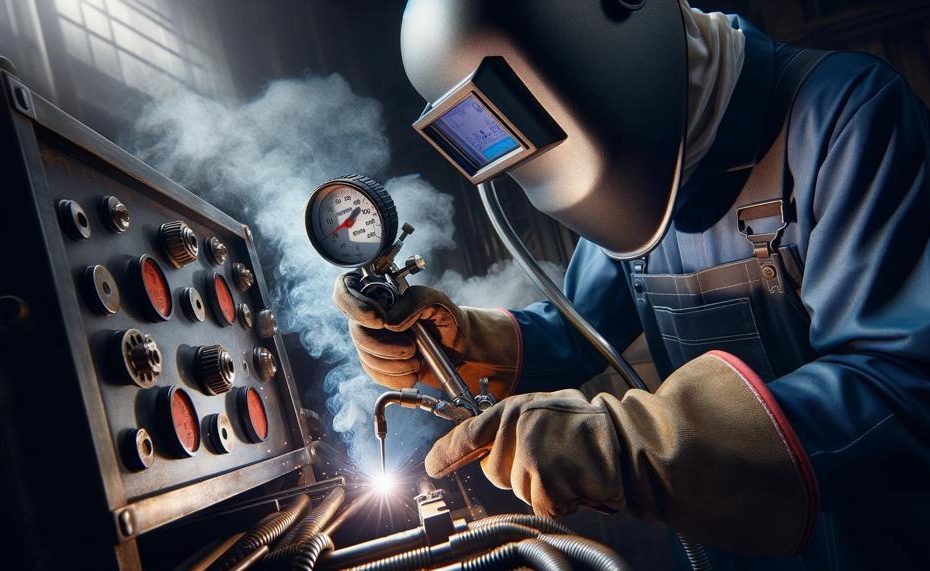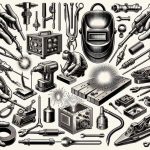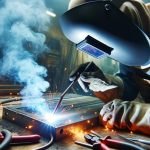Today in the Welder’s Corner, we’ll take the mystery out of one of the most important but often forgotten parts of MIG welding: setting the right argon pressure. Understanding this factor can make the difference between getting perfect welds every time, no matter how experienced you are as a welder or how new you are to the job.
So, what pressure should argon have for mig welding?
A pressure of 3 to 8 pounds per square inch (PSI) is best for MIG welding. Nevertheless, the exact pressure setting may differ depending on whether flow restrictions exist or if the welder is different. When spatter builds up in the tip gas diffuser or the gun wire bends, it can stop the flow. Some say that to function with flow limits, you should put 25 PSI above the flow control opening or needle valve. Others recommend using 25 cubic feet per hour (CFH) for nozzles that are 1/2″ or smaller, and 30 CFH for nozzles that are 9/16″ or larger. When you use too much gas flow, it can cause turbulence and may help stop porosity instead of stopping it.
It’s important to keep the protective gas pressure at or near the right amount to avoid problems with the weld, such as a sponge-like structure, blackening, and oxygen, hydrogen, and nitrogen in the air. Some people say to turn it up a bit if you’re working in a shop with an open ceiling door or a fan blowing air through the room, but not more than 40. That can cause turbulence once the temperature goes above 40, which can pull air in from the outside, leaving holes in your weld.
Let’s dive in.
Contents
- 1 Factors to Consider When Setting Argon Pressure for MIG Welding
- 2 The Ideal Pressure Range for Argon Gas Used in MIG Welding
- 3 How to Determine the Correct Pressure for Your Specific Welding Application
- 4 Tips to Ensure You Have a Properly Filled Tank of Argon
- 5 Safety Precautions When Setting Argon Pressure for MIG Welder
- 6 Benefits of Using the Correct Argon Pressure for MIG Welding
- 7 Common Mistakes Made When Setting Argon Pressure
- 8 Conclusion
Factors to Consider When Setting Argon Pressure for MIG Welding
When determining the appropriate argon pressure for MIG welding, there are several pivotal factors to mull over. This intricate balance involves not just a keen eye for detail but also a thorough understanding of the welding process and the materials at hand.
| Welding Application | Different welding tasks call for nuanced adjustments in argon pressure. Whether you’re joining thin sheets or hefty plates, the application dictates the gas flow rate. |
| Material Type and Thickness | The nature and heft of the material being welded directly influence the required argon pressure. Thicker materials often necessitate a higher gas flow rate to adequately shield the weld pool. |
| Joint Design | Complex joint geometries might require increased argon flow to ensure all crevices are protected from atmospheric contamination. |
| Electrical Current Settings | Higher welding currents can benefit from a slight uptick in argon pressure to counterbalance the increased heat and turbulence in the weld pool. |
| Electrode Extension | A longer stick-out might lead to a need for a higher gas flow to maintain an adequate shielding envelope around the weld area. |
| Equipment and Nozzle Size | The specifications of your MIG welding gear, including the nozzle size, play a critical role in determining the optimal argon pressure. |
| Environmental Conditions | Outdoor welding or areas with drafts necessitate adjustments in argon flow to ensure the welding area remains shielded from contaminants. |
| Safety and Efficiency | Maintaining the argon pressure within the recommended range ensures not only the quality of the weld but also operational safety and cost-effectiveness. |
In essence, striking the perfect argon pressure for MIG welding involves a dance between the technical specifics of your project and the external factors at play.
The Ideal Pressure Range for Argon Gas Used in MIG Welding
The sweet spot for argon gas pressure in MIG welding is a topic brimming with nuance, hinging on variables like the type of metal being fused and the specific conditions under which the welding takes place.
When you’re in the throes of welding, especially with metals like aluminum or when employing a non-mixed argon gas in your MIG setup, the recommended pressure range isn’t just a number—it’s your ticket to pristine, strong welds without the fuss of spatter or porosity.
For argon gas in MIG welding, especially when dealing with the precision required for materials that respond well to a clean, controlled environment, setting your gas flow correctly is less about sticking rigidly to a rule and more about understanding the dance between gas, metal, and machine.
The ideal range generally falls between 15-25 CFH (Cubic Feet per Hour), which is a guideline rather than a strict limit. This range offers enough coverage to protect the weld pool under most conditions without causing the turbulence that can introduce air and its contaminants into your work.
Here’s a simplified breakdown of recommended settings:
| Material | Thickness | Argon CFH |
| Aluminum | Thin to Medium | 20-30 CFH |
| Stainless Steel | Medium to Thick | 15-25 CFH |
| Mild Steel | Varied | 15-25 CFH |
This table is a guiding light, but remember, the nuances of your specific project may lead you to adjust within these ranges.
For instance, a breezy work environment or a particularly tricky weld joint might necessitate a slight uptick in your gas flow to ensure full coverage without blow-through.
How to Determine the Correct Pressure for Your Specific Welding Application
To pinpoint the right pressure for using argon in your MIG welding gig, you’ll need to juggle a few variables. It’s not rocket science, but getting it spot-on means smoother, stronger welds. Here’s your cheat sheet:
Key Factors to Mull Over
- Material Type and Thickness: Like choosing the right arrow for the bow, match your gas pressure to the metal’s characteristics.
- Weld Joint Type: Different dances require different moves. Same goes for welds – each type has its own gas flow rhythm.
- Nozzle Size: The size of your nozzle affects how much gas gets to the party. Don’t let it crash or overflow.
Golden Rules of Thumb
- Pressure Sweet Spot: Aim for a flow rate between 20-25 cubic feet per hour (CFH). Adjust from there based on your project’s quirks.
- Tank Talk: Keep your argon tank plump at 2000-2200 psi. A healthy tank means a happy weld.
- Regular Check-ups: Keep an eye on that pressure. It’s the pulse of your operation.
Safety First, Always
Messing with argon? Respect it. Secure your cylinder like it’s precious cargo and tweak your settings by the book.
Avoiding the Oops
Don’t be that person who skips the manual or forgets to purge the gas lines. And keep that regulator as tidy as your workspace.
| Variable | Recommended Starting Point | Notes |
| Pressure Range | 20-25 CFH | Adjust based on observation and results. |
| Tank Pressure | 2000-2200 psi | Ensure tank is adequately filled before starting. |
| Safety Checks | Regular | Monitor argon levels and equipment integrity. |
Get these elements in harmony, and you’re not just welding; you’re crafting masterpieces.
Tips to Ensure You Have a Properly Filled Tank of Argon
Ensuring your argon tank is adequately filled for MIG welding involves a few essential steps and precautions to guarantee optimal performance and safety.
Check the Pressure
A full argon tank should register between 2000-2200 psi.
Before initiating your welding project, it’s crucial to verify that your tank’s pressure falls within this range.
Regular Monitoring
Throughout your welding process, keep an eye on the tank’s pressure gauge.
Replenish your argon supply when the pressure dips below 500 psi to avoid running out mid-project.
Storage Conditions
Store your argon tank in a place that’s both cool and dry.
This precaution helps prevent any potential contamination or degradation of the gas quality.
Purchase Quality Gas
Always source your argon from reputable welding suppliers.
High-quality gas ensures the integrity of your welds and reduces the risk of contamination.
Safety First
Secure your argon tank properly and follow the recommended pressure settings as per the welding equipment’s user manual.
This practice is vital for both operational efficiency and safety.
Adjust According to Needs
| Factor | Recommended CFH | Notes |
| Material Type | 20-25 CFH | Vary based on thickness and type. |
| Weld Joint Type | 15-20 CFH | Adjust for joint configuration. |
| Nozzle Size | Depends | Follow manufacturer’s guidance. |
Avoid Common Pitfalls
Consult the manufacturer’s instructions for your specific welding setup to ensure you’re using the correct pressure settings. Regular maintenance of your regulator and purging gas lines before use can prevent inaccuracies and contamination.
Safety Precautions When Setting Argon Pressure for MIG Welder
Setting the argon pressure for a MIG welder is akin to preparing a fine meal; precision, care, and the right ingredients make all the difference.
Below are vital safety measures, ensuring your welding journey is both effective and secure:
| Check Equipment Regularly | Examine hoses, regulators, and tanks for any signs of wear or damage. Like checking the rigging before sailing, ensuring your equipment is in prime condition is crucial. |
| Proper Installation | Connect your argon tank correctly. A misstep here is like missing a beat in a tango; it could lead to leaks or improper gas flow. |
| Leak Test | After installation, conduct a soap solution test around connections. Bubbles forming are telltale signs of a leak, much like smoke signals alerting to fire. |
| Correct Pressure Setting | Adjust the argon pressure between 25-30 cubic feet per hour, based on your welder’s requirements. This precision mirrors a chef’s attention to the temperature for the perfect roast. |
| Use Protective Gear | Wear the right safety equipment: gloves, goggles, and a welding helmet. This is akin to a knight’s armour in battle, indispensable for your protection. |
| Ventilation | Ensure adequate airflow in your workspace. Welding without proper ventilation is like painting in a dust storm; it clouds vision and contaminates the air. |
| Gas Type Knowledge | Understand the specific benefits and considerations of using argon as your shielding gas. This knowledge is as vital as a map to a sailor navigating the seas. |
Embrace these practices with the seriousness of a craftsman perfecting his trade, and you’ll set a solid foundation for a welding process that is not only productive but also safe.

Benefits of Using the Correct Argon Pressure for MIG Welding
When it comes to MIG welding, dialling in the correct argon pressure is akin to hitting the sweet spot in a well-crafted symphony. The recommended argon pressure, sitting comfortably between 15-20 cubic feet per hour, plays a pivotal role in orchestrating a welding process that’s not only effective but ensures the longevity and strength of your welds.
| Consistent Gas Coverage | Ensures a uniform shield around the weld, warding off pesky atmospheric gases that might lead to weld contamination. |
| Optimised Oxidation Reduction | Minimises the risk of oxidation on the weld and surrounding metal, preserving the integrity of the weld area. |
| Enhanced Weld Quality | Leads to smoother, cleaner welds with fewer imperfections, thanks to the stable arc and reduced spatter. |
| Equipment Longevity | Prevents excessive wear on welding equipment by maintaining an ideal flow rate, prolonging the life of your tools. |
| Safety First | Adhering to recommended pressures ensures safe handling and use of argon gas, reducing the risk of accidents. |
Adjusting argon pressure to the task at hand, while keeping within the recommended range, allows welders to adapt to different materials and thicknesses. It’s a bit like adjusting the seasoning in a dish to taste; too little or too much can throw off the balance.
Equally, remembering to maintain your equipment, from regulators to purging gas lines, ensures that the argon pressure remains on point, safeguarding the quality of your welds.
And let’s not forget safety, the backbone of any welding endeavour. By sticking to the recommended argon pressure, you’re not just optimising your welding outcomes but also ensuring that your workshop remains a safe environment, free from the hazards associated with improper gas handling.
Common Mistakes Made When Setting Argon Pressure
When diving into the world of MIG welding, setting the correct argon pressure is akin to finding the perfect rhythm in music; it’s all about precision and understanding.
| Mistake | Consequences | How to Avoid |
| Overlooking Manufacturer’s Instructions | Incorrect pressure settings, leading to subpar welds. | Always consult the welder’s manual for the model-specific guidelines. |
| Ignoring Material and Thickness | Compromised weld quality due to unsuitable pressure. | Adjust pressure based on the workpiece’s specifics. |
| Skipping Purge of Gas Lines | Inaccuracy in gas flow, affecting weld integrity. | Purge gas lines before each welding session to ensure accuracy. |
| Letting Dirt Clog the Regulator | Malfunctioning equipment, leading to inaccurate pressure. | Regularly clean the regulator and check for debris. |
| Running on a Low Tank | Inconsistent gas flow, risking weld quality. | Keep an eye on the tank gauge; refill as needed to maintain consistent pressure. |
| Not Regularly Checking Tank Pressure | Starting a job with insufficient gas, risking project delays. | Verify tank pressure before beginning to ensure there’s enough gas for the job. |
Remember, safety is the linchpin when handling argon gas. By adhering to these pointers, not only do you safeguard your well-being, but you also elevate the caliber of your welding projects.
Conclusion
Now that we’ve talked about how to set the right argon pressure for MIG welding, it’s clear that getting the settings right is very important for making your welds look great. To get the most out of argon, which is a well-known welding tool, you need to use it in a specific way.
Finding the right mix between 15 and 25 cubic feet per hour, based on the job, the material, and the weather, is not only helpful; it’s also necessary for making clean, strong welds. This range ensures that there is enough protection without introducing contaminants or making the weld pool rough.
One important thing to remember is how important it is to change your argon flow to fit the needs of your project, from the thickness of the material to the conditions of your workspace. Furthermore, the emphasis on regular equipment repair and avoiding common mistakes demonstrates how important accuracy and care are when welding.
Protecting yourself and the weld is very important. It is critical to ensure that you handle gas properly and check your tools on a regular basis.
Getting good at setting the gas pressure is like getting good at playing an instrument. When you do it right, it works well with your skills and the job at hand, giving you great results.





